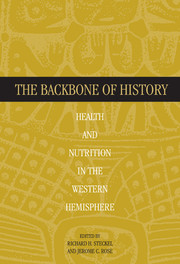Book contents
- Frontmatter
- Contents
- Preface
- List of Contributors
- PART I
- PART II METHODOLOGY
- PART III EURO-AMERICANS AND AFRICAN-AMERICANS IN NORTH AMERICA
- PART IV NATIVE AMERICANS IN CENTRAL AMERICA
- PART V NATIVE AMERICANS AND EURO-AMERICANS IN SOUTH AMERICA
- PART VI NATIVE AMERICANS IN NORTH AMERICA
- PART VII
- PART VIII
- PART IX EPILOGUE
- 21 The Body as Evidence; The Body of Evidence
- 22 Overspecialization and Remedies
- Index
21 - The Body as Evidence; The Body of Evidence
Published online by Cambridge University Press: 01 March 2010
- Frontmatter
- Contents
- Preface
- List of Contributors
- PART I
- PART II METHODOLOGY
- PART III EURO-AMERICANS AND AFRICAN-AMERICANS IN NORTH AMERICA
- PART IV NATIVE AMERICANS IN CENTRAL AMERICA
- PART V NATIVE AMERICANS AND EURO-AMERICANS IN SOUTH AMERICA
- PART VI NATIVE AMERICANS IN NORTH AMERICA
- PART VII
- PART VIII
- PART IX EPILOGUE
- 21 The Body as Evidence; The Body of Evidence
- 22 Overspecialization and Remedies
- Index
Summary
The Greek skeletos, meaning withered or dried up, is the source of the modern word skeleton. The skeletal remains of a once-dynamic living organism would appear to be shriveled or withered if that is all that remains of what was once a vital body and soul. The ancients would have been hard-pressed to use the bones to provide insights into the being of what was once that person. The early history of skeletal biology primarily consisted of descriptive inventories of the sex and age of skeletal remains found in archaeological excavations. The inventories were dry and lifeless, and their publications were forever buried as appendixes in archaeological reports. The analysis and insight in this early era of skeletal biology could easily be described as withered or dried up. Modern researchers now know that the bones of individuals long dead can provide information about the people themselves their physical activities, their diet, and the diseases that afflicted them. The skeletons provide valuable clues as to how people lived and died.
Even after an influential article by S. L. Washburn (1953) heralding the era of the “new physical anthropology” nearly a half century ago, little changed. The new physical anthropology forecasted the replacement of typology and description with the study of process and hypothesis testing. Notwithstanding the promise of the new era of research with an emphasis on process, most skeletal biology remained typological and descriptive.
The development of physical anthropology was hampered by the role it played as the “handmaiden” to history, particularly versions of history that fit common cultural stereotypes (Lasker 1970).
- Type
- Chapter
- Information
- The Backbone of HistoryHealth and Nutrition in the Western Hemisphere, pp. 593 - 602Publisher: Cambridge University PressPrint publication year: 2002
- 3
- Cited by



